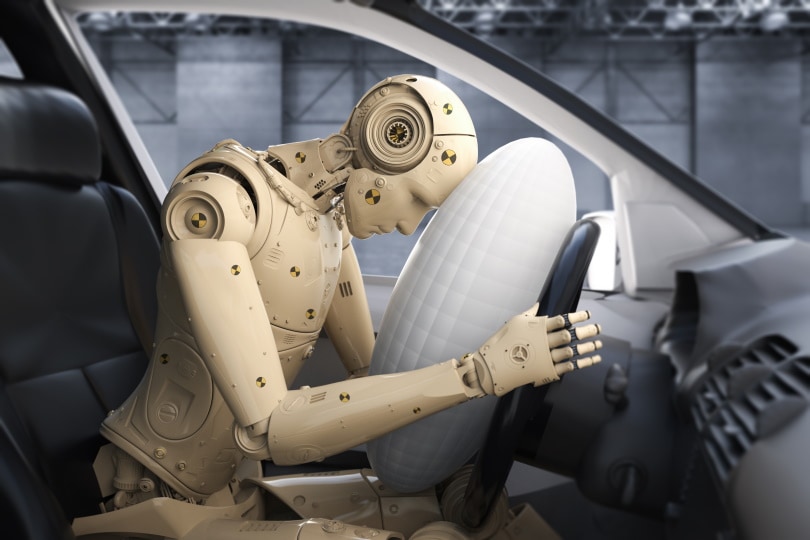How Fast Does an Airbag Deploy? Facts, Factors, & FAQ
-
Pete Ortiz
- Last updated:

Like safety belts, airbags are installed in a car to protect the occupants in case of an accident. But how fast do they actually deploy? Typically, automotive airbags will deploy and cushion a crash in 15–50 milliseconds while traveling at speeds of 100–200 miles per hour. Airbag deployment is so fast that the process happens in the blink of an eye.
The concept of Airbags has been around for many years. However, the first commercial airbags debuted in automobiles around early 1990. They were introduced in motor vehicles in a bid to reduce accident fatalities. This is because the fast speed at which vehicles travel is a major cause of accidents throughout the world. Unfortunately, airbags are still hugely misunderstood because most vehicle owners can drive for years without being in an accident where the airbags get deployed.
Therefore, it is essential to know exactly how fast airbags can deploy to save your life in an accidental collision. Read on to learn more about the process.
How Do Airbags Work?
The idea behind an airbag is pretty straightforward. If your car is involved in an accident, it will screech to an almost immediate stop. However, the deceleration doesn’t affect the objects and occupants inside the car. This can be attributed to inertia, which allows the body to continue moving at the previous speed of the car. It will continue moving until slowed by the steering wheel or safety belt. When the occupants finally stop, the same thing happens inside their bodies, forcing their internal organs to come to a hard stop. This could have catastrophic damage to human beings.
The airbags function by employing “satellite sensors” installed throughout the car to activate the inflator in a severe frontal collision. The sensors determine the deceleration when speeds exceed 15 miles per hour. At these speeds, a signal sent to the inflator detonates a chemical mix of potassium nitrate and sodium azide. The detonation creates an inert gas like argon or nitrogen, which quickly inflates a thin nylon bag. The nylon bag is the part of the airbags we normally see in cars.
As the nylon bag inflates, it pushes through a split in the cover to prevent your face or body from coming into contact with the steering wheel, dashboard, or other surfaces in front of you. When your body hits the soft impact zone, it absorbs the impact by deflating the bag through holes located at the base. This reduces the chances of your head hitting a hard surface.

How Fast Do Airbags Deploy?
Since the airbag deployment process involves detonation and chemical explosion, most people are of the impression that airbag deployment is faster than a gunshot. In the event of a collision, the airbags need to activate before the vehicles’ seat belts reach the slack limit or the occupants get into contact with any part of the interior surfaces. In addition, the airbag has to be fully inflated before the driver or passengers get too close to it, thus minimizing serious injuries from the airbag itself.
As earlier mentioned, a standard airbag will deploy at speeds that range from 100–200 miles per hour, which is like the top speed of the Japanese Shinkansen bullet train. Also, the airbag deployment decision is made in only 1–50 milliseconds for frontal collisions. This is less than a third of the entire accident duration. After achieving successful deployment, the airbag quickly deflates. The entire process can take roughly 0.10 seconds. Moreover, airbags do not deploy in low-speed collisions. The car has to be moving at speeds of at least 12–18 miles per hour.
The driver’s side airbag usually pops out of the steering wheel in 20–30 milliseconds. The passenger bag hidden inside the dashboard usually takes 30–40 milliseconds to ignite and explode. They also deploy when the angle of impact is 30 degrees on either side of the vehicle’s direction. This means that when a car is hit on the side or rolls over, the frontal airbags will not deploy.
The thin nylon bag inside the airbag also has a maximum inflation pressure of 5 pounds per square inch (psi) for several reasons. Due to the low pressure in the airbag, deceleration speed is still slower in an accident, giving the body more time to slow down. If the airbag deployed any faster than 100–200 miles per hour, it would create more problems than it would solve. The car would also need more explosives to ignite and inflate the airbag. Consequently, this would increase burns or minor injuries from airbag deployment.

When Do Airbags Deploy?
As earlier mentioned, the airbag system features a series of sensors that are activated by the airbag control module (ACM). Also known as the black box or EDR, the control module receives readings from the gyro meter, accelerometer, and other sensory equipment installed around the vehicle.
The ACM monitors the sensors for any tell-tale signs of possible collisions. The ACM immediately starts recording after detecting signs of a car crash. These signs include accelerations higher than is normal on several car parts meant to detect early signs of a car crash. The ACM will then prompt the airbags to deploy as soon as the conditions that indicate a car crash are met.
The system also relies on readings from all the sensors in a vehicle to make a deployment decision. If the system relied on one type of sensor, like the impact sensors, the airbags would deploy when it is too late to be effective. Also, if there aren’t enough sensors to transmit data to the ACM or the conditions are set to low, the airbags would deploy too soon or even when a crash hasn’t occurred.
Why Don’t Airbags Deploy in Certain Collisions?
Not all vehicle collisions prompt the airbag to deploy. This is because there are a variety of factors that determine the successful deployment of an airbag. These factors are fine-tuned by the manufacturer to ensure activation only when necessary. This is perhaps prompted by the emphasis on reducing airbag-related injuries and the invention of onboard computers that determine whether or not to deploy airbags in moving vehicles. So, it’s no surprise that airbags do not deploy in all crashes, even when the occupants thought it was necessary.

These factors include the direction of the impact and speed of the crash, features of the accident, and other vehicles that may have been involved in the crash. So, the next time you crash into another vehicle or hit a stationary object and the airbags don’t deploy, it could be because of the following reasons:
1. Minor Accidents
When a car crash is moderate, the airbag may not deploy. The crash condition may not have warranted the deployment of airbags to protect the car’s occupants. The situation is common where the seat belt may have offered sufficient protection after an accident.
2. Child Detection
Some motor vehicle manufacturers have been releasing innovative features changing vehicle safety standards. One such feature is the advanced frontal airbag system, which detects the presence of a child or a small-bodied passenger in the front seat.
In the event of an accident, the system will not deploy an airbag if you have a child under 13 years or a person less than 153 centimeters tall. Such small-statured people often sustain serious injuries from frontal airbag deployment. Moreover, the airbag may fail to deploy because there is no occupant in the front seat, deeming deployment unnecessary.
3. Already Deployed Airbags on Second-Hand Cars
If you bought a second-hand vehicle, chances are that the airbags may not deploy in case of an accident. This is usually because the previous owner may not have been able to replace the airbags after a previous accident. Ideally, you should always replace airbags after an accident where they deployed.
Conclusion
Airbags are essential safety components in motor vehicles because they can protect you from severe injuries in case of a car crash. As a general rule of thumb, never purchase any vehicle without first checking whether it is installed with functional airbags.
Airbags can deploy at rapid speeds, often equated to the blink of an eye. It will take 15–50 milliseconds for a car traveling between 100–200 miles per hour for the airbags to deploy. Because of the rapid reaction speed, airbags can also be dangerous with the potential to scratch and bruise your face after deployment. Therefore, ensure that every occupant in the car is safe even after the accident.
Sometimes, a fully operational airbag system may fail to deploy due to several reasons. If you had a seat belt strapped while driving or had a young child in your front seat, the airbags may not deploy. They will also fail if you own a second-hand car whose airbags were not replaced after a previous crash.
Featured Image Credit: Maksim Vivtsaruk, Shutterstock
Contents



